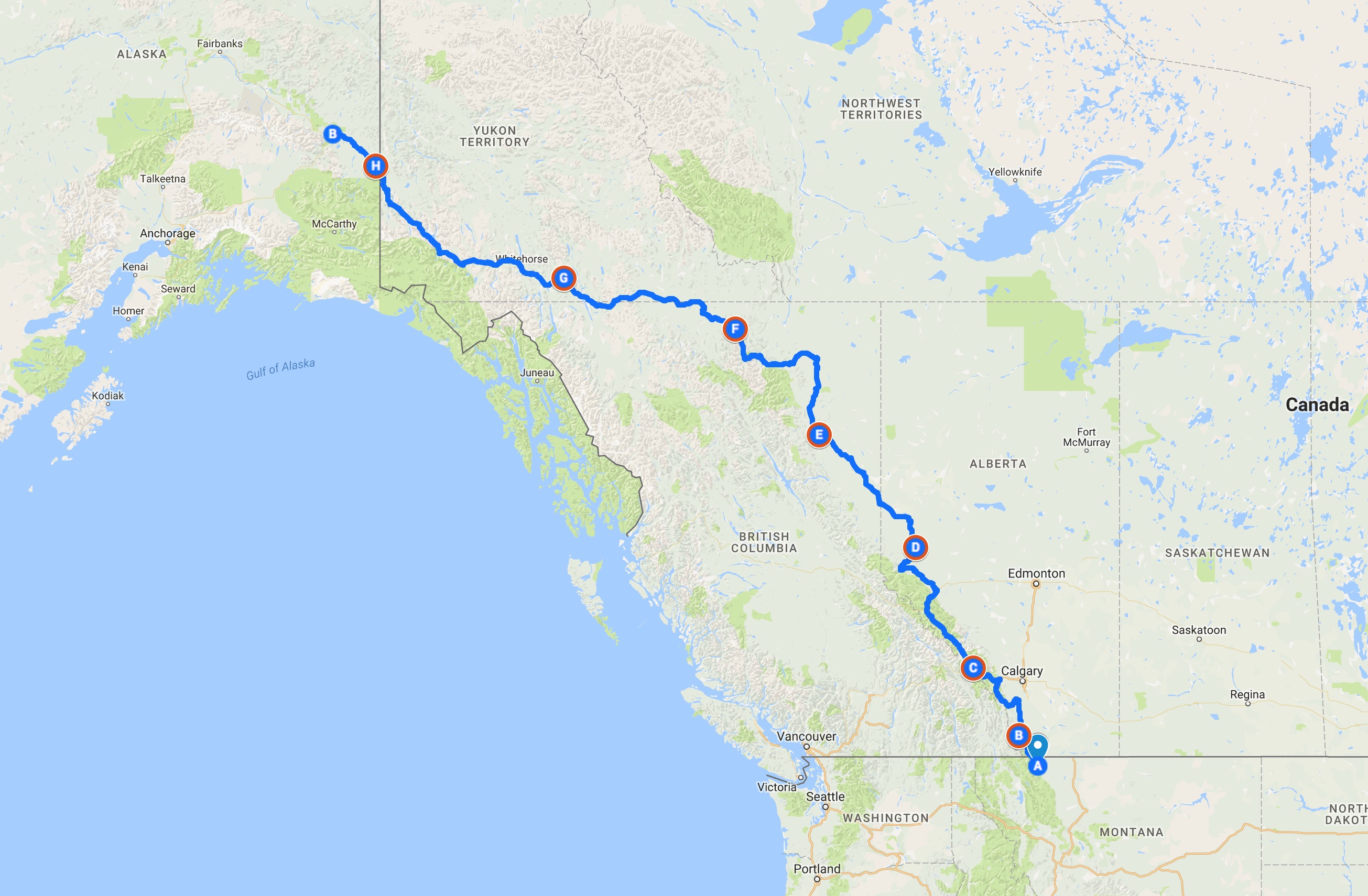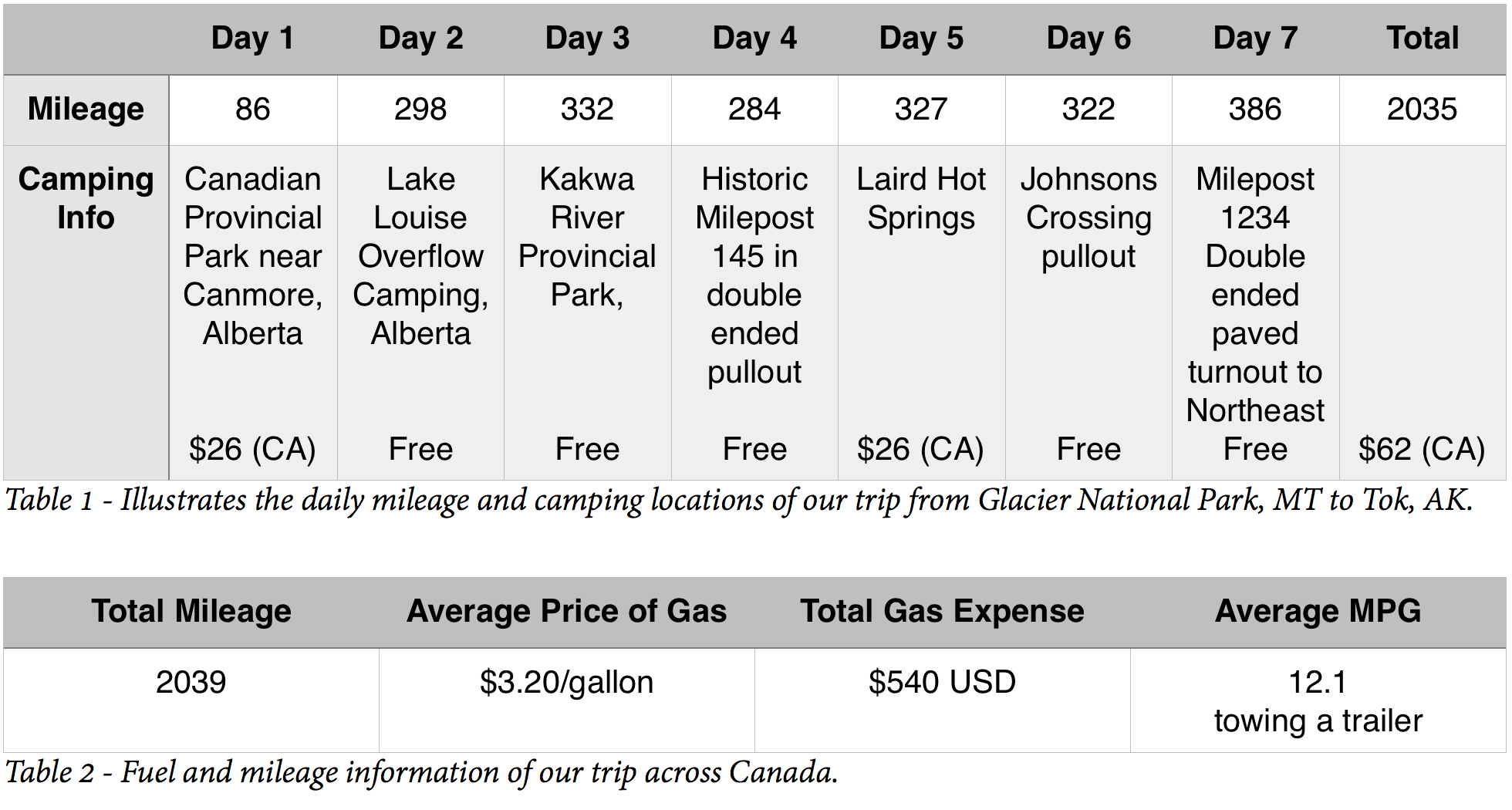
Alaska bound: Crossing Canada
Deciding to drive to Alaska was almost a no-brainer, but figuring out the logistics of what was actually involved in getting there and what to do once we arrived was quite a bit more complicated than either of us bargained for. In addition to an exhausting list of things we absolutely HAD to do, everyone we spoke with who had actually driven to Alaska, also cautioned us that what we were planning was no small undertaking, and typically shared a horror story or two about fearsome road conditions, flat tires, broken axels and/or near death experiences with large mammals.
Overwhelmed by the number of incredible options of things to do coupled with an overbooked work schedule in the months leading up to our departure date, we found ourselves at the Chief Mountain Border Station just outside of Glacier National Park with nothing planned other than a roughed out road map of how we planned to drive across Canada. The rest, we were just going to have to figure out along the way.
 Map of our trip across Canada. The points reference are where we camped.
Map of our trip across Canada. The points reference are where we camped.
 Moraine Lake, near Lake Louise in Banff National Park was one of our early (and favorite) discoveries along our journey.
Moraine Lake, near Lake Louise in Banff National Park was one of our early (and favorite) discoveries along our journey.
 While the hue of the water was reminiscent of the Caribbean Sea, the arctic temperature of the water on our early morning paddle across Moraine Lake perfectly matched the landscape - breathtaking!
While the hue of the water was reminiscent of the Caribbean Sea, the arctic temperature of the water on our early morning paddle across Moraine Lake perfectly matched the landscape - breathtaking!
 The Columbia Icefield is the largest glacier in Canada and definitely worth a stop to explore.
The Columbia Icefield is the largest glacier in Canada and definitely worth a stop to explore.
We found the wilds of Canada to be quite conducive to winging it. Almost immediately we settled into a rhythm of short periods of driving, punctuated by frequent stops to take in one impressive sight after another that we discovered along the way. As dusk approached at the end of each day, we pulled out our comprehensive guidebook, The Milepost, to help us find a suitable pullout or campground where we could park for the night. For the most part we opted to boon-dock in one of the many fantastic pullouts that lined the highway to Alaska. One noteworthy exception was the night we spent at the Laird Hot Springs Provencial Park. Our camping fee included access to the hot springs and we took full advantage with both an evening and morning soak in the soothing waters.
 The Laird Hot Springs is a mandatory stop on the Alaskan Highway. There are two pools that start at 125 degrees at the source of the spring and that cool to around 70 degrees as you make your way downstream. While at the park, it was berry season and the park was overrun with black bears. At dawn we saw a mother and her cub right outside the RV, and Abby and I spotted a moose on our early morning walk to the springs.
The Laird Hot Springs is a mandatory stop on the Alaskan Highway. There are two pools that start at 125 degrees at the source of the spring and that cool to around 70 degrees as you make your way downstream. While at the park, it was berry season and the park was overrun with black bears. At dawn we saw a mother and her cub right outside the RV, and Abby and I spotted a moose on our early morning walk to the springs.
 We caught a glimpse of Athabasca Falls as we rounded a bend and had to stop and check it out. There is a labyrinth of trails that flank the river on each side where you can peer over the lip of the box canyon and feel the pounding of the water reverberate in your chest. It's an extraordinary place to stop and stretch your legs.
We caught a glimpse of Athabasca Falls as we rounded a bend and had to stop and check it out. There is a labyrinth of trails that flank the river on each side where you can peer over the lip of the box canyon and feel the pounding of the water reverberate in your chest. It's an extraordinary place to stop and stretch your legs.
One of the most striking differences between travel in the lower forty-eight and that in the great white north, is the complete lack of any obvious development (other than the road of course). It is the most remote roadway we have ever experienced with endless miles of nothing but us, the road stretching off into the distance and a plethora of wildlife. Along the way we spotted an abundance of wildlife, all of which were fascinating to watch, but presented a notable hazard while driving.
From the wolf we noticed loping along the tree line to the bison that lined, and sometimes lounged in the road to the numerous caribou, moose, elk, stone sheep and bear crossings, we sometimes felt like we had inadvertently stepped into a high-stakes game of large mammal dodgeball. As a safety precaution, we opted to forego driving at dawn and dusk in an effort to avoid a collision as we traveled through the more desolate areas of Canada.
 We spotted this big fella wading in a roadside lake near Jasper.
We spotted this big fella wading in a roadside lake near Jasper.
 Bison lined the road for hundreds of miles starting around Dawson Creek. These beautiful and impressive creatures made for a sizable speed bump as they lounged in the road. Fortunately we took it easy through this stretch of highway and were able to avoid several near misses.
Bison lined the road for hundreds of miles starting around Dawson Creek. These beautiful and impressive creatures made for a sizable speed bump as they lounged in the road. Fortunately we took it easy through this stretch of highway and were able to avoid several near misses.
 A definite highlight of our trip was visiting the Sign Forest in Watson Lake, Yukon. We thought it would be cool, but were shocked at the massive scale of this ever expanding sculpture.
A definite highlight of our trip was visiting the Sign Forest in Watson Lake, Yukon. We thought it would be cool, but were shocked at the massive scale of this ever expanding sculpture.
 Of course we had to leave our mark on the Sign Forest with a handmade Famagogo work of art.
Of course we had to leave our mark on the Sign Forest with a handmade Famagogo work of art.
As we crossed the physical border into the Yukon, we noticed that quite suddenly we had also transitioned from summer into fall. The foliage changed from varying shades of green to vibrant hues of reds, oranges and yellows and crisp nighttime temperatures that suddenly yielded frost on our windshield. The road conditions for the final 200 mile push to the Alaskan border deteriorated to such an extent that we were forced to creep along at 45 MPH, doing our best to spot frost heaves in the road with enough warning to slow down enough to avoid seriously damaging Winnie the View.
After seven days and 2035 miles, we finally reached the US border. Our journey across Canada was one for the memory books and something we look forward to tackling again sometime. With little more planned than a rough outline of the regions we want to visit, we are crossing into the wilds of Alaska, eager to explore the unknown and discover the adventures that await us. Onward.
You can follow our adventures in realtime on Facebook @Peter.Holcombe, @Kathy.Holcombe or @AdventurousMissAbby or on Instagram @PeterHolcombe or @Adventurous.Miss.
Comments
Comments on this post are moderated, so they will not appear instantly. All relevant questions and helpful notes are welcome! If you have a service inquiry or question related to your RV, please reach out to the customer care team directly using the phone numbers or contact form on this page .
